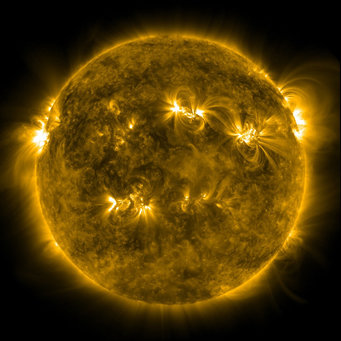A new look at the Sun’s magnetic field
Max Planck researchers discover how the strength of a forthcoming activity cycle can be predicted
Sunspots, bursts of radiation and violent eruptions are signs that our Sun is permanently active. Researchers have long known that this activity varies in a cycle of around eleven years’ duration. Even if many questions are still unresolved, one thing is certain: magnetic fields which emerge on the surface of our Sun from within its depths are the cause of the manifold activities. Robert Cameron and Manfred Schüssler from the Max Planck Institute for Solar System Research in Göttingen have now proved that it is possible to deduce what the internal mechanism is simply by observing the magnetic processes on the surface. This even allows predictions to be made about the strength of a forthcoming activity cycle.

The Sun is a huge ball of gas in whose interior hot gases flow, rise and sink. Inside this inferno, a magnetic field is generated whose fundamental structure is similar to that of Earth’s magnetic field. It takes the form of a dipole whose magnetic field lines emerge from the surface at the solar poles.
The magnetic fields are, however, bound to the hot, electrically conducting gas, and this gas stretches and warps the fields in a complicated way – like rubber bands in honey which is stirred. A magnetic field line originally running parallel to the axis of rotation is thus entrained by the rotating gas.
The gas in the equatorial region moves much faster than in middle and high latitudes, however. This means that the field lines in the equatorial region are stretched lengthwise and actually twist tight in the course of several rotations: a ring-shaped magnetic field forms in the east-west direction, also called a toroidal field.
These magnetic field lines can merge to form thick bundles that rise up until they eventually emerge from the surface and form a loop. The familiar, dark solar spots form at the two points of emergence. They therefore usually occur in pairs in the east-west direction and form a magnetic north and south pole respectively. Over an eleven-year cycle, the magnetic orientation of all spots is identical. The toroidal field is therefore always in the same direction.
“Until now, many experts believed that the magnetic phenomena which manifest themselves to the outside are only the symptoms of the processes taking place in the interior,” says Manfred Schüssler from the Max Planck Institute for Solar System Research in Göttingen. “We have now applied a mathematical theorem that the Irish mathematician and physicist George Gabriel Stokes proved in the 19th century.”
This theorem relates the fields at the surface to those in the interior of a body. The scientists used this purely mathematical argument to prove that the magnetic field which can be measured at the surface of the Sun is the sole source for the ordered toroidal field in its interior, which, in turn, causes the activity phenomena of the subsequent eleven-year cycle.
“What we see on the surface is the relevant field,” says Schüssler. “Figuratively speaking, the surface phenomena are not the tail of the dog, but the dog itself.”
By comparing them with observational data, Robert Cameron and Manfred Schüssler were able to show that the dipole field is far and away the dominant source of the toroidal field. They have thus confirmed a model which the American astronomers Horace Babcock and Robert Leighton had already proposed in the 1960s.
This also now allows predictions to be made about the strength of an upcoming activity cycle. Over the course of an eleven-year cycle, the dipole field changes its direction: the magnetic north pole becomes the south pole and vice versa. The new dipole field reaches its maximum strength roughly in the phase of minimal solar activity.
As the dipole field is the source of the toroidal field of the next cycle, its strength should be a measure of the activity of the next cycle. Such a correlation has already been established: “During the phase of the last minimum around 2009, the strength of the dipole field was relatively low, and the present cycle is correspondingly weak,” says Schüssler.
In future it will be possible to test the predictive power further. Until now, it has been very difficult to measure the strength of the dipole field, as the solar poles are hardly visible from Earth. This should change when, in 2017, the Solar Orbiter is launched. This solar telescope will approach the Sun to within one-third of the distance Earth-Sun and also rise above the plane of the terrestrial orbit. It will thus afford us a view over the polar regions.
The Max Planck Institute for Solar System Research is involved in the construction of four instruments on board the Solar Orbiter, and also has overall responsibility for a camera known as the Polarimetric and Helioseismic Imager.
TB/HOR
